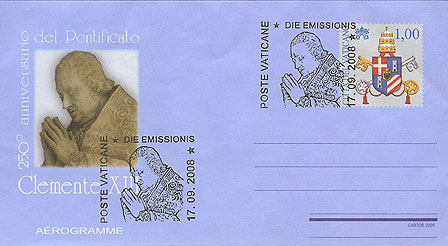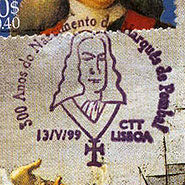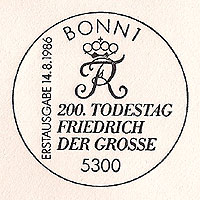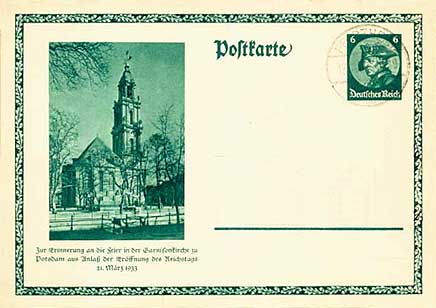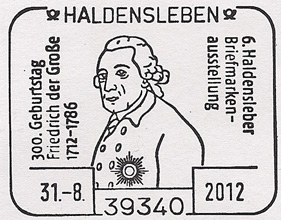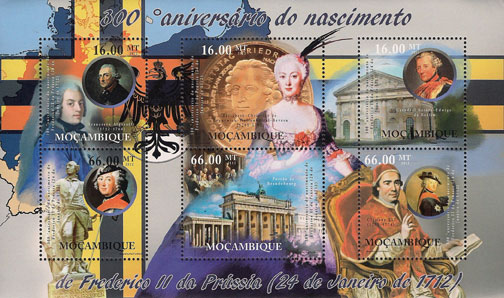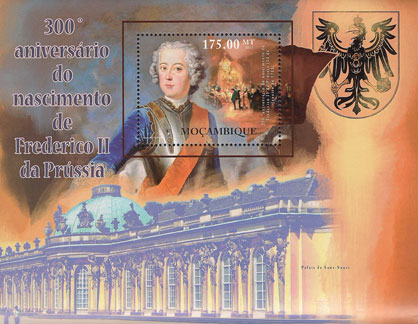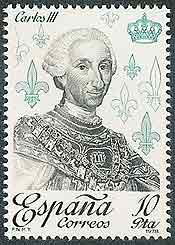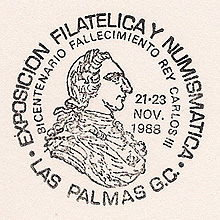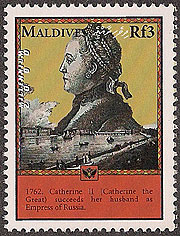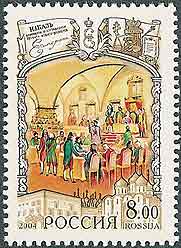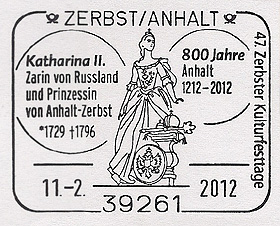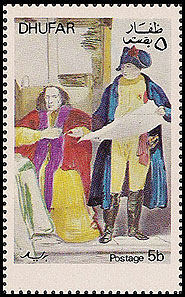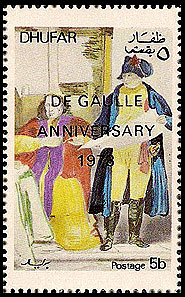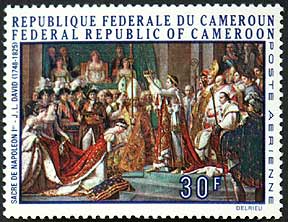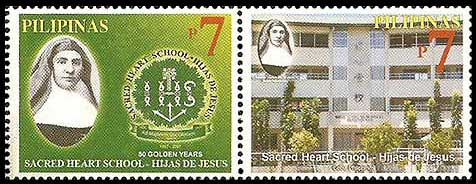Pope Clement XIII
(1693 -1769)
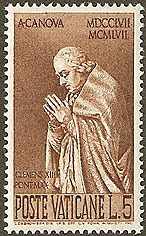
VATICAN CITY, 1959, bicentennial of sculptor Antonio Canova, showing statue by him, Scott 243
VATICAN CITY, 2009, aerogramme honoring the 250th anniversary of his reign.
The images of the Pope kneeling in prayer is taken from his funerary monument in St. Peter's Basilica done by Antonio Canova.Clement XIII (Carlo della Torre Rezzonico) was educated by the Jesuits at Bologna. When he was elected to the papacy in 1758, the Portuguese and Bourbon courts were seeking the Suppression of the Society. Clement remained faithful to his old teachers and their order. He wrote to the King of France, to the bishops of France and to other bishops of the world protesting the proceedings of the Parlement again the Order. When finally Parlement suppressed the Jesuits in France in August of 1762 he protested and annulled the laws against them. Three years later at a time when forces were moving strongly to suppress the Society of Jesus throughout Europe, Clement issued his papal bull of 9 January 1765, Apostolicum pascendi. He rejected the calumnies misrepresenting the Jesuits, their institute, spiritual exercises, and ministry, and their theology, he gave formal solemn approval to them, and argued that an attack on their values was an attack on the Church.
The Marquês de Pombal
Sebastiâo José de Carvalho e Mello
(1699 -1782)

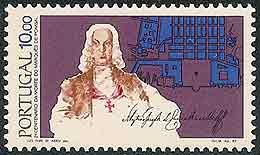
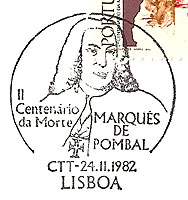
PORTUGAL, 1972, the bicentenary of Pombal's reform of the University of Coimbra, Scott 1153
1982, the bicentenary of his death, Scott 1553 & its FDI cancel
1984, Pombal Palace wall tile, Scott 1594From the time of his appointment as Minister of Foreign Affairs in 1750, possibly through the influence of a Jesuit, Pombal continued to solidify his power over other nobles and even over the king. He came into conflict, real or imagined, with the Jesuits and had them banished from the court, then seized their properties in Portuguese territories, expelled or imprisoned them, and conspired with other royal courts to force the Pope in 1773 to suppress the order entirely.

PORTUGAL, 1999, the tercentenary of his death, Scott 2295 and its FDI cancel
PORTUGAL, 1999, the tercentenary of his death, Scott 2296
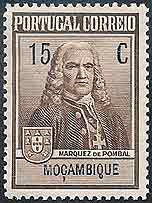

PORTUGAL, ANGOLA, AZORES, CAPE VERDE, MACAO, MADEIRA, MOZAMBIQUE, NYASSA, PORTUGESE GUINEA, PORTUGUESE INDIA, ST. THOMAS AND PRINCE, and TIMOR, 1925, Scott CD 28-33In order to raise money for a memorial to Pombal, Portugal in 1925 issued 3 postage tax stamps and overprinted them as 3 postage tax due stamps to collect double the amount if the first tax had not been paid. These were issued in the homeland and in eleven colonies, all using the same common designs. Thus except for denomination, color and overprinting the above three types account for 72 stamps. They show a portrait of the Marquês, a picture of him planning the reconstruction of Lisbon, and his monument in Lisbon.
Pope Clement XIV
(1705 -1774)
VATICAN CITY, 1959, bicentennial of sculptor Antonio Canova, showing Canova's image of the Pope
from his tomb in the Church of the Twelve Apostles, Scott 244
DOMINICA, 2000, the Millennium series of Popes souvenir sheet, Scott 2234

SAN MARINO, 2005, the tercentenary of the Pope's birth, Scott 1661-62
MOZAMBIQUE, 2011, a souvenir sheet for Frederick the Great below includes an image of Clement XIV on one of its stamps and some of its selvage.
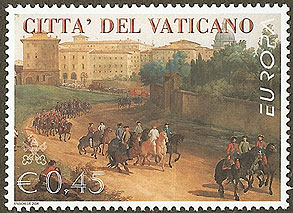
VATICAN CITY, 2004, Europa theme for the year: Vacations, Scott 1267-1268
featuring frescoes of Clement XIV on vacation at Castel GandolfoAs Cardinal Giovanni Vincenzo Antonio Ganganelli was elected Pope Clement XIV, the Jesuits had been suppressed de facto in France, Spain, and Portugal. Now civil rulers pressed the new Pope to abolish the Order de jure everywhere, and had even required him to make a commitment to this purpose as a prerequisite to his election. While educated by the Jesuits at Rimini and dependent even on the influence of Fr. Ricci, the superior general of the Order, for his creation as cardinal, Clement sided with the Bourbon monarchs, persecuted the Jesuits and finally in the brief Dominus ac Redemptor (July 21, 1773) suppressed the Order. The brief, however, did not impugn the Jesuits, their teaching or morals, and seemed to suppress the Order for the good of the Church rather than from animosity to the Jesuits. It lacked the authority of a papal bull, and was not promulgated in the usual fashion, so that the Swiss cantons of Lucerne, Fribourg, and Solothurn as well as Frederick the Great of Prussia and Catherine the Great of Russia were able to maintain the Jesuit presence in their domains. A second brief Gravissimis ex causis (August 16, 1773) established a commission of 5 cardinals entrusted with the task of informing the Jesuits and handling the many practical problems caused by the Suppression.
The 2004 Vatican issue honoring vacations pictures the vacations of Pope Clement XIV at Castel Gandolfo. He regularly spent the month of October there, and it was there that he consented to the abolition of the Jesuits. He had a small room fitted up with a table for playing a kind of billiards, the balls being thrown by hand. Two frescoes in that room represent scenes in which he is seen with his entourage at the Castel. In one he is on horseback wearing a white riding coat he had specially made for himself; in the other he is taking a stroll in the garden. More
Frederick the Great of Prussia
(1712-1786)
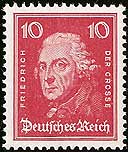

GERMANY, 1926, series of composers, Scott 355
1986, bicentennial of his death and its FCI cancel, Scott 1469
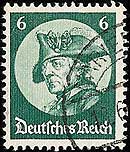

GERMANY, 1933, Potsdam Day, Scott 398-400 and postal card

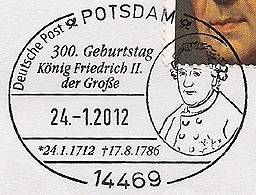
GERMANY, 2012, for Frederick's 300th anniversary and its FDI cancel, and special show cancel later in the year, Scott 2647
When the Society of Jesus was suppressed, the Pope permitted the rulers of individual countries not to issue the bull of suppression. Catherine of Russia was the most famous of those who did not promulgate the bull, but Frederick II of Prussia was another. On September 13 1773 he informed Pope Clement XIV that the Jesuits would not be suppressed in Prussia.
